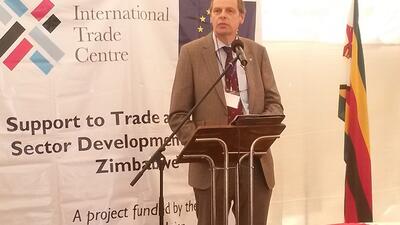
Zimbabwe receives €1.2 million to implement Cotton-to-Clothing sector strategy (en)
(Bulawayo) Secretary-General of the Common Market for Eastern and Southern Africa (COMESA) Sindiso Ndeme Ngwenya and Zimbabwe’s Minister of Industry and Commerce, Mike C. Bimha, have announced that €1.2 million will be dedicated to achieve the targets of the recently launched Cotton-to-Clothing sector strategy for Zimbabwe, which was facilitated by the International Trade Centre (ITC).
COMESA has allocated a total of €4.2 million to Zimbabwe under the Regional Integration Support Mechanism, which is funded by the European Union. The funds will be used for value-addition programmes in Cotton-to-Clothing, leather products and other sectors, Mr. Ngwenya said.
‘The €1.2 million in funding has been allocated specifically to kick-start the implementation of this strategy, to ensure that implementation starts immediately,’ Mr. Ngwenya said at the launch of the strategy in Bulawayo on 26 September, addressing more than 200 stakeholders from Zimbabwe and the region.
‘It is my hope that this will help incentivize the Government to step in to create an enabling environment for the private sector to expand the textile and clothing industry,’ he said.
ITC’s Deputy Executive Director Dorothy Tembo underlined the importance of strategy implementation to achieve a series of domestic production and manufacturing targets to revitalize Zimbabwe’s Cotton-to-Clothing sector by 2019.
‘Successful implementation will help the sector to once again become a major driver of broad-based growth in Zimbabwe,’ Ms. Tembo said.
Representatives from Zimbabwe’s public sector, rural communities, small and medium-sized enterprises and civil society worked together for six months to define market-led development priorities for their sector. The resulting strategy is aligned with COMESA’s strategy for the Eastern and Southern Africa region’s Cotton-to-Clothing value chain and includes targets such as a 71% increase in yields that would benefit 250,000 smallholders, a steep increase in yearly seed-cotton production, and a US$ 110 million export target for textiles and garments by 2019.
The strategy was developed by Zimbabwe’s Ministry of Industry and Commerce, with technical assistance from ITC and COMESA, and was funded by the European Union under the EU-Africa Partnership on Cotton, and the African, Caribbean and Pacific Group of States.
ITC’s regional-strategy approach, based on the requirements of the private sector, has unified policymakers in building links between the pan-African cultivation of cotton and textile manufacturers. Zimbabwe’s strategy is aligned with the goals of the ITC-facilitated COMESA-wide Cotton-to-Clothing strategy that launched in 2009 and is designed to increase linkages to boost production of the region’s value-added cotton-related products and services.
In 2010, the West African Economic and Monetary Union (UEMOA) launched an ITC-facilitated strategy that targeted the need to manage the region’s cotton cultivation. In 2011, the ITC-facilitated strategy for the Economic Community of Central African States (ECCAS) aimed to strengthen the Cotton-to-Clothing sector while addressing the needs of the region’s fragile states.













